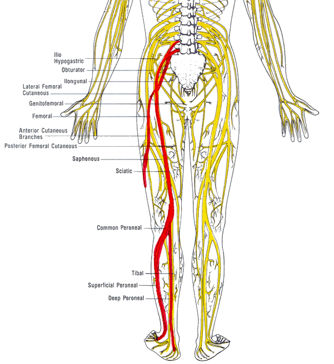Sciatica is also called Sciatic Neuritis

The sciatic nerve is the longest and largest single nerve of the body. It is composed of five nerve roots. The nerve roots that exit between the 4th and 5th lumbar vertebrae (the L4 nerve) and the 5th lumbar and sacrum (L5 nerve) are involved. The 1st, 2nd and 3rd sacral nerves which exit from the sacrum, also contribute to the sciatic nerve. The sacrum is comprised of five bones that fuse in adulthood to become one large bone.
The sciatic nerve supplies muscle strength and sensory perception to the leg. It is also responsible for the leg’s reflexes. It connects the brain with the outside of the thigh and the hamstring muscles in the back of the thighs. It also supplies muscles in the lower leg and feet.
As such, when the sciatic nerve is impinged or irritated, it can lead to muscle weakness and/or numbness. Patients often experience tingling in the leg, ankle, foot, and/or toes as well.
In chiropractic practice, we see on a daily basis, VERTEBRAL SUBLUXATIONS of the L4 and L5 vertebrae, sacrum and the ilium bones. The ilium bones are often called hip bones and attach on either side of the sacrum forming the sacro-iliac joints.
